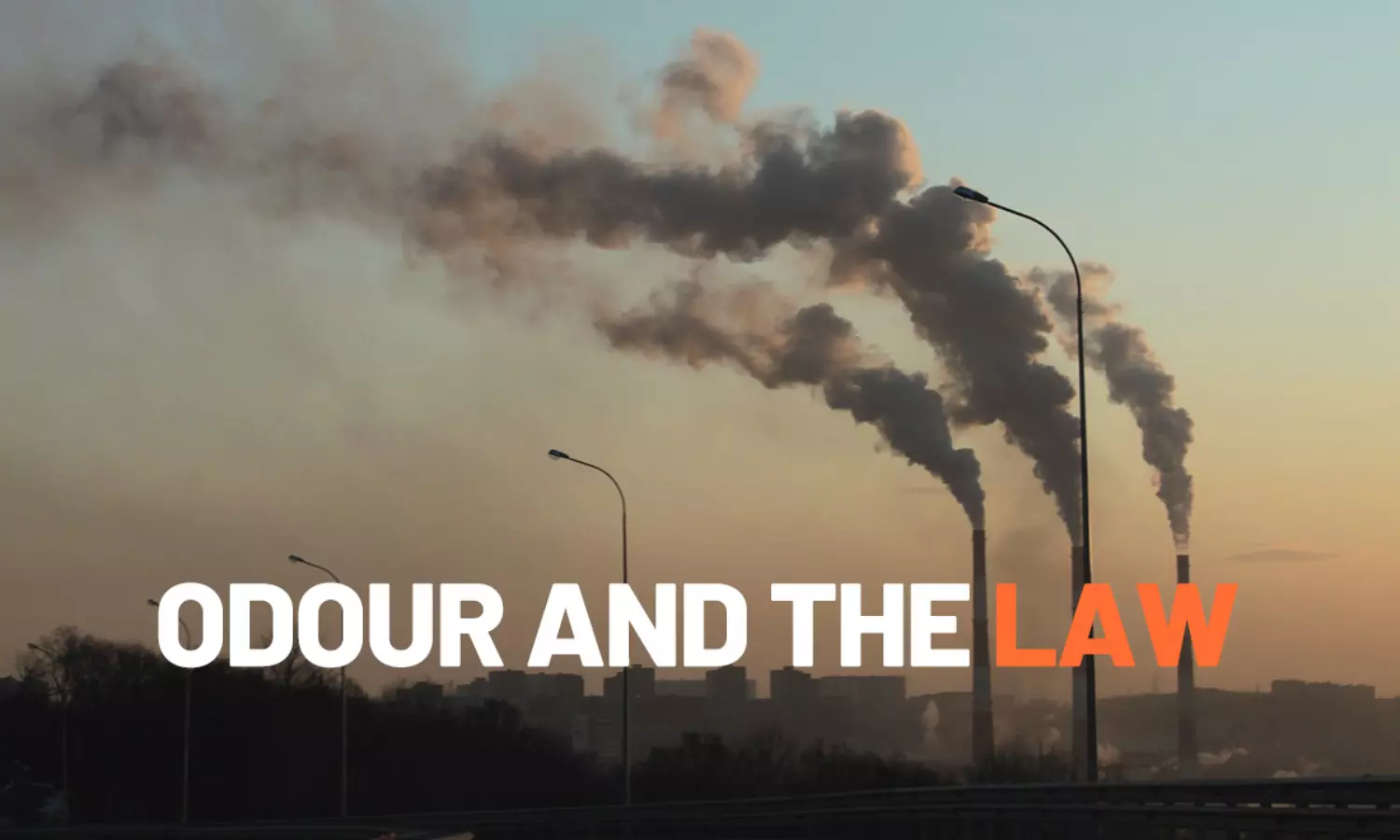
Odour - a strong, mostly unpleasant smell - has proven to be a nuisance on several occasions in India. Undesirable odour is often indicative of an environmental problem that impacts health and human well-being. Like how, notably, in 1858, it was the “Great Stink” of the polluted Thames River and not the contagious diseases being spread that prompted the UK Parliament to take action...
Odour - a strong, mostly unpleasant smell - has proven to be a nuisance on several occasions in India.
Undesirable odour is often indicative of an environmental problem that impacts health and human well-being. Like how, notably, in 1858, it was the “Great Stink” of the polluted Thames River and not the contagious diseases being spread that prompted the UK Parliament to take action and allow the construction of the main sewers in London.[1]
A significant contributor to odour emissions is industrial plants, especially those involved in environmental management like wastewater treatment plants and landfills. In India, odour because of an open drain nearby or a smelly landfill outside are situations that have unfortunately become commonplace. Even the experience of going to the Taj Mahal, India’s most iconic tourist attraction, has been affected because of the presence of a foul smell - likened to the smell of rotten eggs - that has been attributed to hydrogen sulphide emitted from the Yamuna River.
The World Health Organization has recognised odour as an air pollutant and noted that even though odour annoyance “cannot be regarded as an adverse health effect in a strict sense” it does affect the quality of life. In fact, there has been extensive research on the negative impact of odour on humans with the results ranging from mental fatigue to pathological outcomes. Odour can also affect the economic front by way of lowered productivity, reduced economic activity, decreased tourism and lowered house prices.
At present, there is no comprehensive framework that governs odour in India. Only non-binding guidelines exist.
Odour And The Law In India
Schedule II and Schedule VI of the Environmental (Protection) Rules, 1986 state that efforts, as much as possible, to remove odours should be made.
However, there are only two industries wherein odour removal is mandated as per industry-specific standards and those are the fermentation and natural rubber industries.[2]
Other major odour pollution-causing industrial sectors like paper, pesticide, petroleum etc., do have emission limit values set but these values aren’t based on odour (though they might include odorous emissions at times).
The Central Pollution Control Board came out in 2008 with certain guidelines on odour pollution and its control pursuant to the constitution of an Expert Committee on Odour Pollution and its Control in 2002. The document includes an explanation of odour and its technicalities, case studies in India, and also international legislation and regulations regarding odour.
The guidelines end with a few recommendations made by the Expert Committee on Odour Pollution and its Control, like the adoption of the report of the Expert Committee as a guideline for odour pollution and its control. The implementation of an accurate and acceptable odour measurement system and the establishment of source-specific standards for odour emission from industries were also recommended.
Odour then found mention in a government document in 2016 titled ‘The Centre’s Solid Waste Management Rules’ in which it was identified as a “public nuisance”.
In 2017, the CPCB conducted its first pilot study on Odour Monitoring in the Municipal Solid Waste (MSW) landfill site at Ghazipur, East Delhi - the oldest landfill in Delhi - and concluded by detailing guidelines on odour monitoring in an Urban MSW Landfill. This study, “Odour Monitoring and Management in Urban MSW Landfill Sites”, acknowledged that odour regulation in India is still in its nascent stages. It also described the problem of odour as undoubtedly the most complex of all air pollution problems.
The 2017 study identified odour monitoring challenges such as low awareness of odour as a public nuisance and a lack of legislative obligations.
The 2008 guidelines were reiterated in the study and the need for installation of sensor-based Continuous Odour Measurement Systems like the ones that have already been adopted by the CPCB for air, water and noise pollution was stressed upon since for legislative norms to be initiated, a baseline data needs to be created.
The CPCB newsletter in 2020 also mentioned the difficulties in developing regulatory threshold limits for odour like the lack of indicative compounds within odour plumes and the dearth of odour emission measuring devices.
In 2019, in the case of RWA Society vs Govt. ofNCT of Delhi, the issue for consideration before the National Green Tribunal (NGT) was remedial action against a bad odour from the Sewage Treatment Plant, Kondli in Delhi. Through a series of orders, the NGT directed the Delhi Jal Board (DJB) to provide an effective odour control mechanism and take requisite steps for odour minimisation. In July 2021, the Principal Bench of the NGT expressed its disappointment regarding the DJB’s failure to have performed its obligation of preventing odour at the STP. It also noted that no steps for installing odour control systems had been taken and “merely dosing of Ferric Chloride, Primary Thickener-A covering and some plantation can hardly be held to be adequate steps in the matter.” These “superficial steps” were held ineffective in the absence of an effective odour control unit. The application was disposed of on November 12, 2021, with the order stating that the foul smell must be remedied. Till the odour control system was installed, interim effective arrangements were to be made for the control of odour and compliance with standards. After installation of the odour control system, it was to be duly assessed.
Foreign Jurisprudence And The Way Forward
Odour emissions are clearly a cause for concern. They are a major component of air pollution complaints and even otherwise have a significant influence on the quality of life.
In Europe, odour is regulated to a certain degree through the Industrial Emissions Directive (IED) of the European Parliament. This 2010 Directive applicable to the member-states of the European Union includes a general framework for determining odour limits for many industrial activities. However, since the IED is limited to governing industrial emissions only, odour control is limited.
Most countries in Europe do not have a law at the national level regarding odour. A notable exception is Germany which brought into force in 2021 its new Air Quality Law which finally included odour as a parameter to evaluate Air Quality. Unlike other European odour limits, this legislation is a general limit of odour in ambient air since it applies to activities of all sectors and not just industrial emissions.
In the United States, the Environmental Protection Agency does not specifically regulate odorous emissions but since it regulates pollutants, sulphur dioxide is the only regulated odour in the United States. However, states and local jurisdictions have tried to regulate odours themselves.
Japan has had odour legislation at the national level for a significant amount of time now. Since there was rapid industrial development and urbanisation in the 1970s, odour complaints increased exponentially which meant that Japan had to enact the ‘Offensive Odour Control Law’ in 1971 and enforce it in 1972. This law promotes odour prevention measures and regulates odours emitted by business activities.
In India, as a result of the absence of a proper legal framework, nuisance prevention law is usually resorted to, to abate odour. Mitigating odour can be challenging in India because of this absence of a legal framework and financial constraints. But an odour law with well-defined compliance criteria is important and international regulations on odour can serve as an excellent starting reference point for the Indian Government to also develop and adopt more stringent odour regulating and controlling policies.
Uniform environmental legislation in India regarding odour would be beneficial for industries and citizens alike since the clear-cut rules would make compliance easier for industries and protection sounder for citizens. And for this to become a reality in India, information about this issue needs to be disseminated so that steps towards building and adopting the appropriate scientific and administrative infrastructure start. This article is my attempt at contributing towards this cause.
Views are personal.
1. https://www.env.go.jp/en/air/odor/measure/02_1_3.pdf
[2] Environment (Protection) Rules, 1986, Schedule I.
[3] The new regulation on Air Quality of Germany came into force in December, Olores.org (Jan. 10, 2022), https://www.olores.org/en/news-recent/odour-regulations/1137-published-the-new-law-on-air-quality-of-germany#:~:text=That is, since the first,than 1314 hours every year.
[4] Anna Bokowa et al., Summary and Overview of the Odour Regulations Worldwide, Atmosphere 2021, Feb. 2021, at 27.




